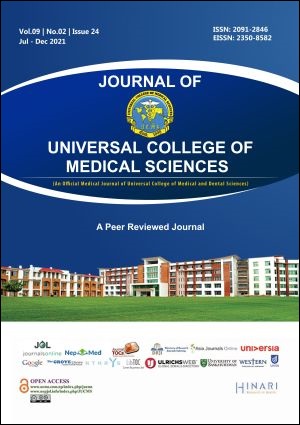Burden of Intestinal Parasitic Infections among Children from Five Schools in Bhairahawa, Nepal: A Comparative Cross-Sectional Study
DOI:
https://doi.org/10.3126/jucms.v9i02.41993Keywords:
Enteric parasitic infection, Routine microscopy, Nepal, Sedimentation,, FloatationAbstract
INTRODUCTION: Intestinal parasites cause significant morbidity and mortality, particularly in the tropics including Nepal. The main objective of this study was to explore the burden of intestinal parasitic infections among children in 5 different primary schools in Bhairahawa, Nepal.
MATERIAL AND METHODS: This was a cross-sectional comparative study among 408 children from 5 schools in Bhirahawa, Nepal. Stool specimens collected in a plastic container were transported to microbiology laboratory in Universal College of Medical Sciences Teaching Hospital (UCMSTH) immediately. Each sample was examined macroscopically and microscopically for the evidence of parasitic infection. All samples were re-analysed by sedimentation and floatation concentration techniques one after another.
RESULTS: The overall prevalence of the parasitic infection was 46.5%. The prevalence varied by the methods that included routine microscopy (23.2%), sedimentation (41.6%) and flotation (8.3%). Ascaris lumbricoides was the most common (29.1%) parasite followed by Entamoeba histolytica (6.1%). Mixed infection was also seen in 7.8% of the samples. Factors such as children’s academic year, age, religion, existing illness, household water sources, meat consumed, domestic animals at house, and recent history of taking anti-helminthics were significantly associated with the intestinal parasitic infections. Prevalence of intestinal parasitic infection was higher in public school (61.1%) compared to private school (37%). Male students had slightly more infections (47.3%) than females (45.7%).
CONCLUSIONS: Enteric parasitic infection was very high among the primary schools’ students in Bhairahawa, Nepal. Integrating concentration techniques in routine test can help to detect most of the enteric parasites in stool specimens.
Downloads
Downloads
Published
How to Cite
Issue
Section
License
Copyright (c) 2021 Journal of Universal College of Medical Sciences

This work is licensed under a Creative Commons Attribution-NonCommercial 4.0 International License.
Authors have to give the following undertakings along with their article:
- I/we declare that this article is original and has not been submitted to another journal for publication.
- I/we declare that I/we surrender all the rights to the editor of the journal and if published will be the property of the journal and we will not publish it anywhere else, in full or part, without the permission of the Chief Editor.
- Institutional ethical and research committee clearance certificate from the institution where work/research was done, is required to be submitted.
- Articles in the Journal are Open Access articles published under the Creative Commons CC BY-NC License (https://creativecommons.org/licenses/by-nc/4.0/)
- This license permits use, distribution and reproduction in any medium, provided the original work is properly cited, and it is not used for commercial purposes.




